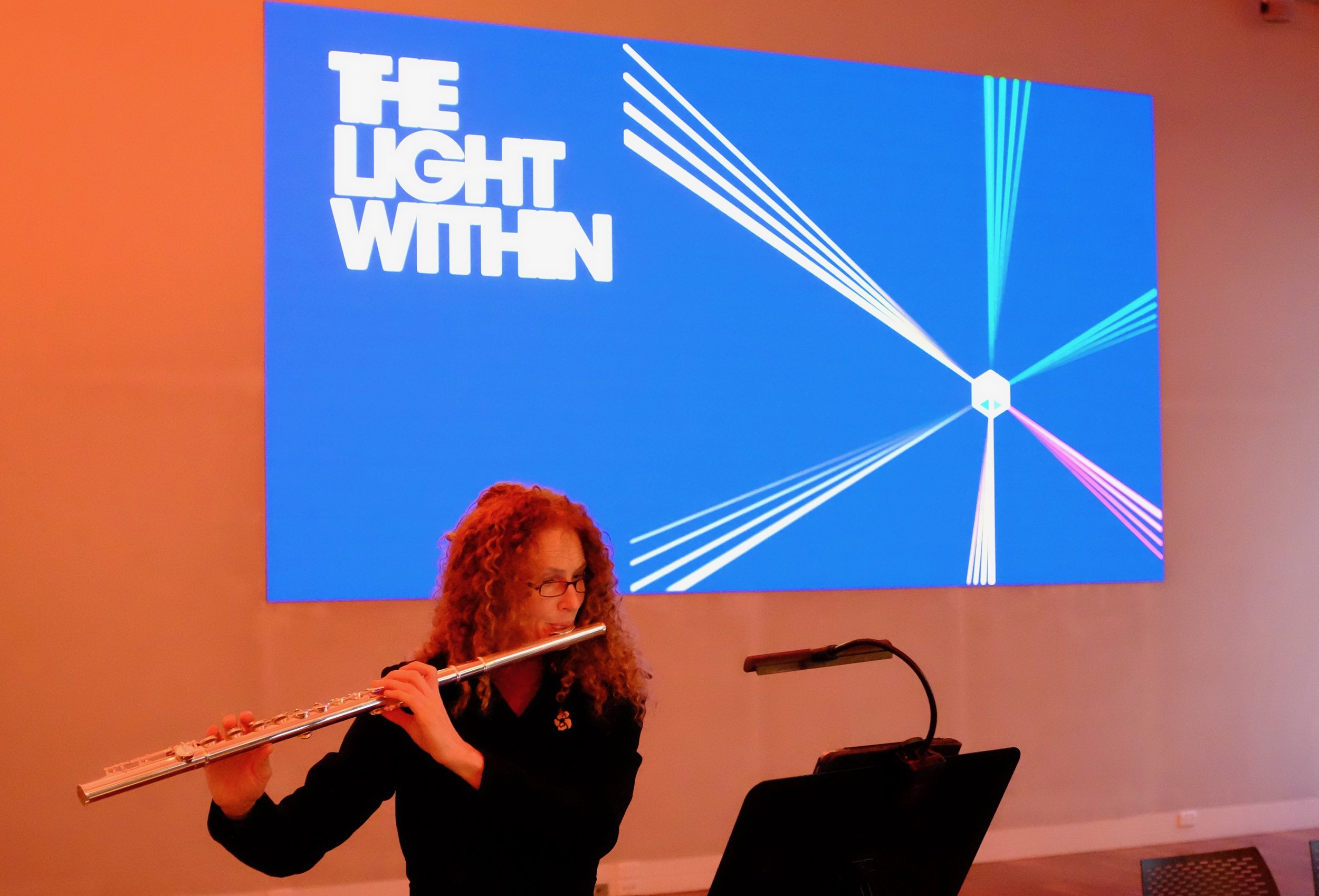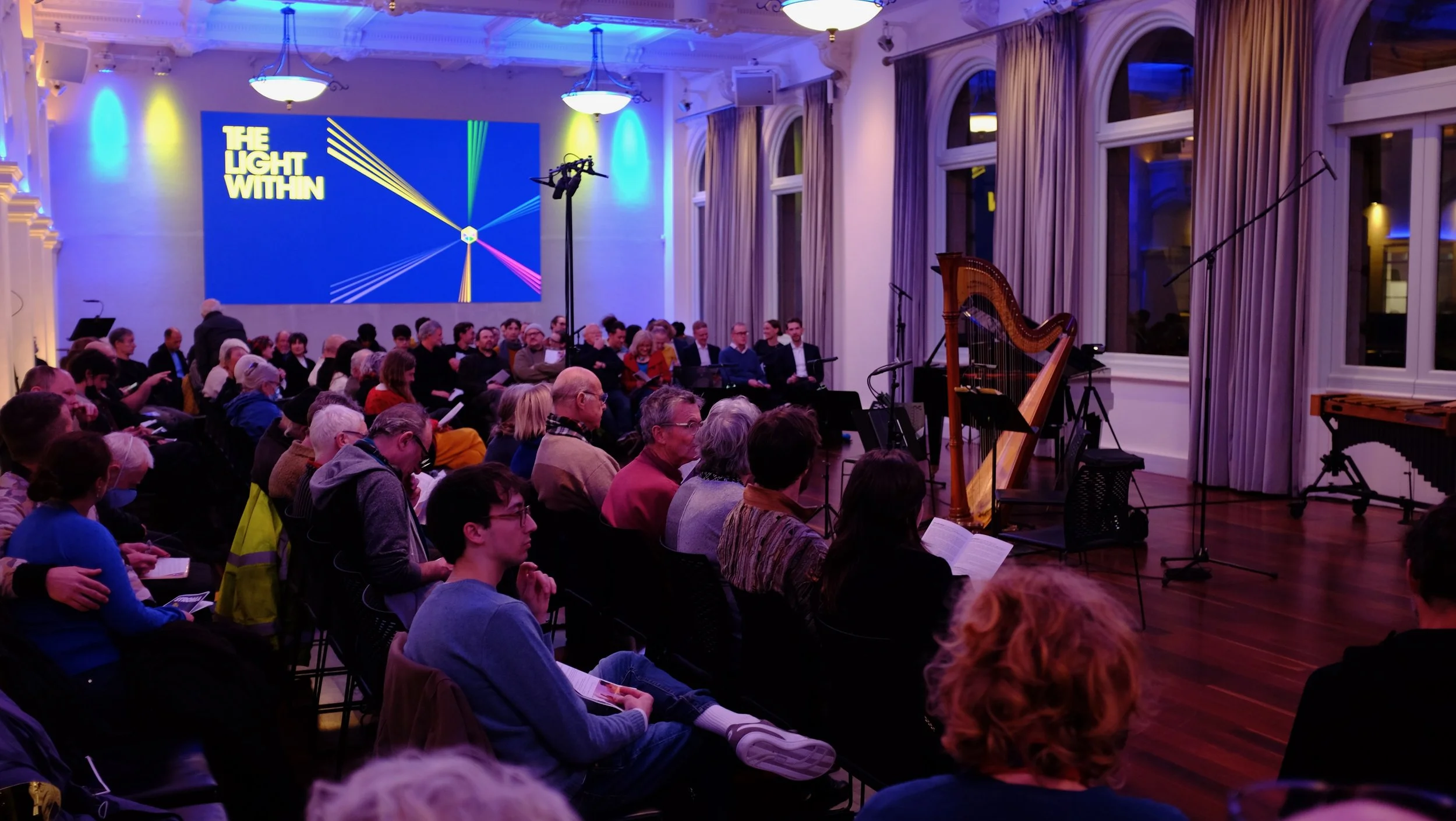STROMA: playing with light and colour
Flutist Bridget Douglas of STROMA
Photo supplied
Wellington’s resident new music ensemble Stroma named its recent kaleidoscopic concert ‘The Light Within’, after a chamber work composed in 2007 by American John Luther Adams. The elegant interior of the Public Trust Hall was lit with changing colours throughout the evening, enhancing the programme theme connecting light, colour and sound.
The brilliant programme, curated by composer Michael Norris and other ensemble members, illustrated vividly why Stroma is such an important and stimulating part of our musical fabric. This twenty-year-old ensemble locates us in a wider world with an international musical context. Its programme notes and spoken introductions draw the audience in with relevant and inspiring information. It consistently presents superb performances of the music of our time by major contemporary composers, as in this concert, and places these within a deep artistic context of concepts and ideas.
The Light Within is an introspective chamber work, its harmonic and timbral hues complex, its shadows deep, with a hint of menace in a dark dream. The ensemble was positioned around the audience, with piano and tuned metal percussion (vibraphone and crotales) in front of us, and alto flute, bass clarinet, violin and cello in the corners of the hall. An electronic track, with occasional low-pitched growls, added to a sense of “sound-surround”.
Meeting by American artist James Turrell
…inspiration for John Luther Adams’ chamber work The Light Within
Audiences may remember the vast palindrome of Adams’ immersive Become Ocean, played by the NZSO last year. The Light Within, though of smaller proportions, is similarly meditative and immersive, inspired by the composer’s ‘epiphany of light’ while experiencing a ‘skyspace’ art installation, Meeting, by Quaker artist James Turrell, in New York.
Finnish composer Kaija Saariaho, whose death aged 70 last year deprived us of one of the most striking voices of her generation, has been widely praised for her work in contemporary opera. In 1988, soon after she moved to Paris (her home for the rest of her life), she expressed her dual interests in dreams and in combining voices with instruments with the chamber work Grammaire des rêves, performed here by Stroma. Love poetry by French surrealist poet Paul Éluard is set for an ensemble of soprano and alto voices, flutes, harp, viola and cello.
Finnish-born composer Kaija Saariaho
“…expressing her interest in dreams by setting the surrealist poetry of Frenchman Paul Éluard for voices and chamber ensemble.”
The work is seductive and gorgeous, with marvellously French colours and textures and dreamlike movement. Saariaho uses a collage of poetry to express passion, regrets and yearning. The lovely voices of soprano Barbara Paterson and alto Cadence Chung worked well together, Paterson dramatic and expressive, Chung less extrovert but using her darker tones with subtle grace. The ensemble, under the baton of conductor Mark Carter, maintained a lovely flow through the challenging score, the instruments weaving intricate and colourful lines around the singers.
Leila Adu-Gilmore’s note for her piece Alyssum, which opened the programme, had an immediately appealing first sentence. “If anyone,” wrote the New York-based Ghanaian New Zealander, “was ever deserving of a piece being written in their honour, it is my Mum.” Her note connects her work through apt metaphor to the concert’s ‘light’ theme, referring to her mother Alison’s darkly sharp wit and light-hearted love of bossa nova, comparing her hardiness and beauty to the starry white plant for which the piece is named.
Scored for string quartet and harp, Alyssum begins with rhythmic ostinati for pizzicato strings and harp, lively writing with tongue-in-cheek cheer. The asymmetrical rhythm of the bossa nova slips into the texture, becoming a quirky presence throughout the rest of the piece. The structure is episodic, exploring fragments of romantic tunes, dreamy counterpoint, a lovely harp solo. There’s a certain, maybe deliberate, vagueness to thematic development, contributing perhaps to my feeling that the work was a bit loose and overlong.
Members of STROMA play Alyssum by Leila Adu-Gilmore
(from left) Anna van der Zee, Julia Broom (violins), Michelle Velvin (harp), Nicholas Hancox (viola)
“…lively writing with tongue-in-cheek cheer".”
Composer and percussionist Bree Van Reyk plays important roles in Australia’s contemporary music scene, including as one of the founders of Ensemble Offspring, Stroma’s equivalent across the Tasman. Her work Light for the First Time is dedicated to her daughter and imagines the moment when a baby in the womb first opens her eyes at around 28 weeks’ gestation.
The core ensemble of flute, bass clarinet, tuned metal percussion, piano and violin begins quietly and gently, the pitch range very narrow, capturing that initial moment of wonder. As textures become grittier and more complex, the ensemble is augmented by a second flute and another violin, located in the corners of the hall. Pitches are sustained, colours shift, melodic fragments from piano are repeated by percussion. The music becomes a little agitated, with faster tempi and more multifaceted textures leading to a very lovely final section of floating harmonies and melodies. It’s an intriguing piece, inspired by imaginative ideas about our first encounter with changing light.
Rainbow Dust in the Sky for violin, viola and cello was created in 2018 by Italian composer Daniela Terranova. Tiny gestures, breathy harmonics and sul ponticello (on the bridge) bowing offer ghostly echoes and snippets. We recognise the oscillating song-phrase “Someday I’ll wish upon a star/And wake up when the clouds are far behind me” from the iconic 1930’s ballad Somewhere over the Rainbow. The appealing little piece feels like a lullaby, perhaps, or the kind of light drizzle that falls when a rainbow forms in the sky.
I was well aware, while training and teaching in Toronto, Ontario in the 1970’s, of Canadian composer R. Murray Schafer as a major force in music and music education. I still have his books, The New Soundscape and The Rhinoceros in the Classroom, on my shelf. His String Quartet No 2 ‘Waves’, played by Stroma, was composed in 1976 and inspired by his acoustic studies of the natural environment, using his discovery that ocean waves on Canadian coastlines are usually 6-11 seconds apart.
Within the concert theme, the work is more about ‘waves’ than ‘light’, though the watery transformations and continuous movement remind us of the changing colours and sparkles of Debussy’s La Mer. Schafer’s thinking was modernist, considering the different musical parameters of pitch, duration, timbre and dynamics as separate organising forces. His score is precisely notated with many instructions to the players.
Cellist Ken Ichinose during the theatrical ending of R. Murray Schafer’s String Quartet No 2 ‘Waves’
“…alone on the stage, he seeks his colleagues.”
His meditative ‘Waves’ has a droll, theatrical ending. The 1st violinist leaves the stage, followed by the 2nd, and then the viola. They take up positions behind the audience, playing quiet little motives and fragments. After a while the solitary cellist stops playing, looking around, puzzled, seeking his colleagues. Eventually he plays a fierce low note, pauses, repeats it – and the piece is over.
Over the years, Stroma has commissioned and premiered many works by New Zealand composers. The programme ended with the world premiere of a Stroma commission by Canadian composer and cellist Nicholas Denton Protsack, currently resident in Wellington while undertaking doctoral studies at the NZ School of Music.
Protsack introduced his work, A Gleaming Thing, referring to the inspiration of the particle accelerator, the Large Hadron Collider, in Switzerland, and his interest in constraint and collision in musical processes. His piece, written for flute, clarinet, percussion, piano, violin and cello, begins with a single unchanging pitch, and I was reminded of his compatriot Schafer’s interest in separating musical parameters, as that pitch was transformed over several minutes by rhythm, timbre and dynamic levels.
The work has a coiled intensity building towards what the composer called a “slow motion explosion”. The changes wrought by the different parameters mean the pitch itself becomes the subatomic “gleaming thing” of the title, as the work unfolds and the action increases. Percussion rhythms become dance-like, other pitches slide, there are shrieks from the flute, small ephemeral gestures and falling arpeggiated passages which lead to the big explosive sounds of the conclusion. It’s a compelling and sophisticated piece that I hope to hear again, and a fitting conclusion to an imaginative and thought-provoking programme.
STROMA New Music Ensemble
…an essential part of our musical fabric
STROMA ‘The Light Within’, music by Leila Adu-Gilmore, Bree Van Reyk, Daniela Terranova, John Luther Adams, R. Murray Schafer, Kaija Saariaho and Nicholas Denton Protsack. Michael Norris (Artistic Director), Mark Carter (conductor) Wellington, 1 August 2024






